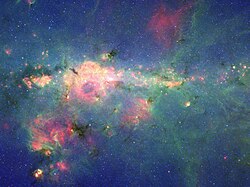 The "Peony Nebula," as discovered by NASA's Spitzer Space Telescope. This three-color infrared composite shows 3.6-micrometre light in blue, 8-micrometre light in green, and 24-micrometre light in red. The Peony nebula is the reddish cloud of dust in and around the white circle, surrounding the Peony nebular star. | |
| Observation data Epoch J2000. Equinox J2000. | |
|---|---|
| Constellation | Sagittarius |
| Right ascension | 17h 46m 18.12s[1] |
| Declination | −29° 01′ 36.5″[1] |
| Characteristics | |
| Evolutionary stage | Slash star |
| Spectral type | Ofpe/WN9[2] |
| Apparent magnitude (J) | 13.0[1] |
| Apparent magnitude (H) | 10.3[1] |
| Apparent magnitude (K) | 8.8[1] |
| J−H color index | 2.7[1] |
| J−K color index | 4.2[1] |
| Variable type | |
| Astrometry | |
| Distance | 26,000[2] ly (8,000[2] pc) |
| Details | |
| Mass | ~100[3] M☉ |
| Radius | 92[2] R☉ |
| Luminosity | 2,950,000[3] L☉ |
| Temperature | 25,100[2][3] K |
| Age | ~2[3] Myr |
| Other designations | |
| Database references | |
| SIMBAD | data |
WR 102ka, also known as the Peony star, is a slash star that is one of several candidates for the most luminous-known star in the Milky Way.[5]
- ^ a b c d e f g Cite error: The named reference
2masswas invoked but never defined (see the help page). - ^ a b c d e Cite error: The named reference
barniskewas invoked but never defined (see the help page). - ^ a b c d Cite error: The named reference
oskinovawas invoked but never defined (see the help page). - ^ Cite error: The named reference
peonywas invoked but never defined (see the help page). - ^ Steinke, M.; Oskinova, L. M.; Hamann, W. -R.; Sander, A. (2015-01-01). "The Wolf-Rayet stars WR102c and 102ka and their isolation". Wolf-Rayet Stars: 365. Bibcode:2015wrs..conf..365S.